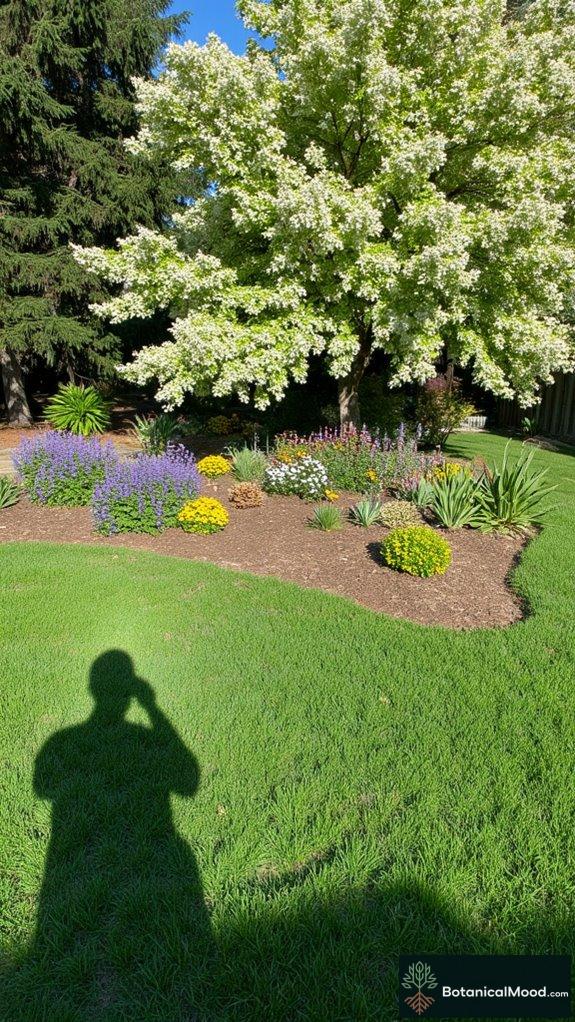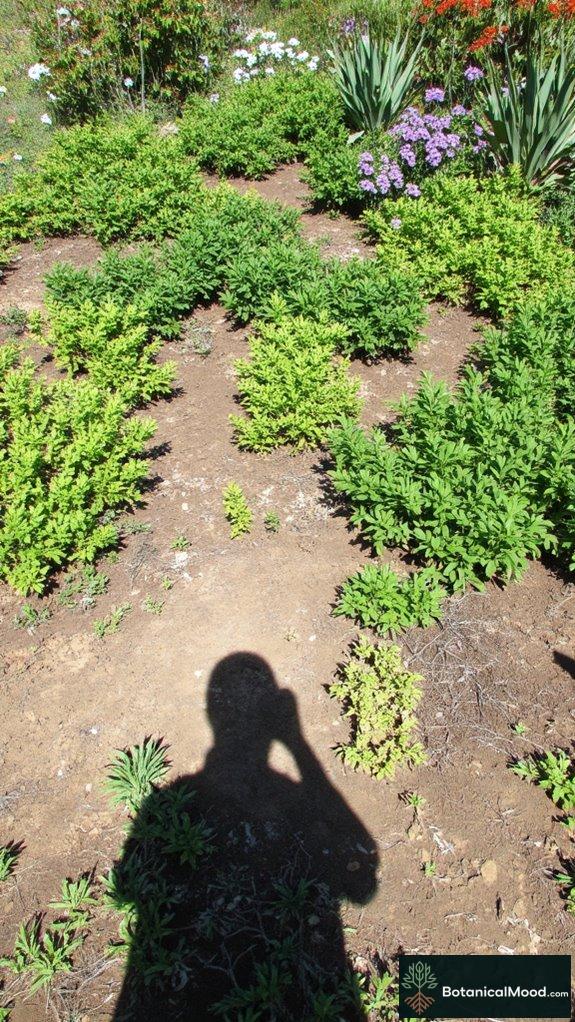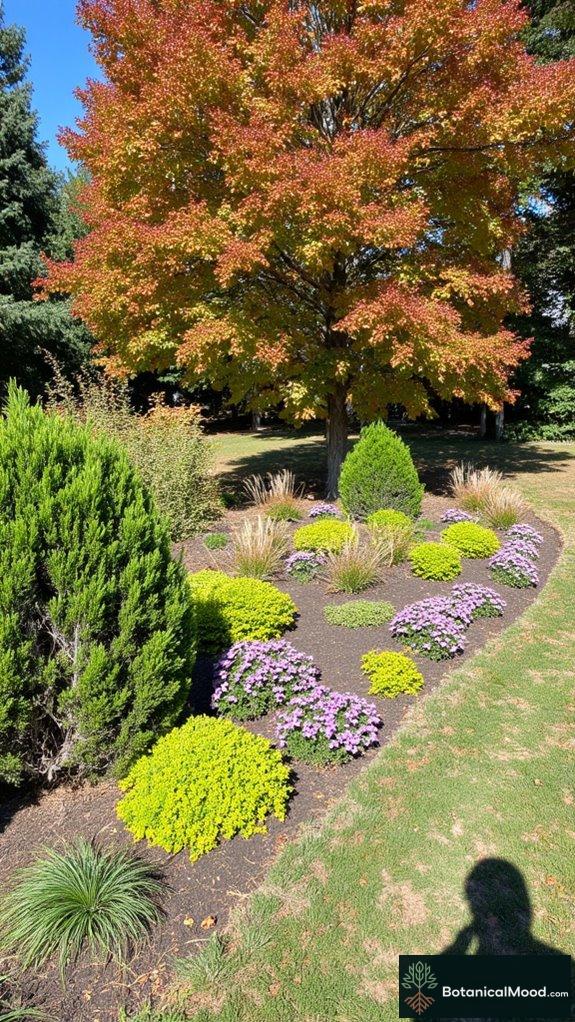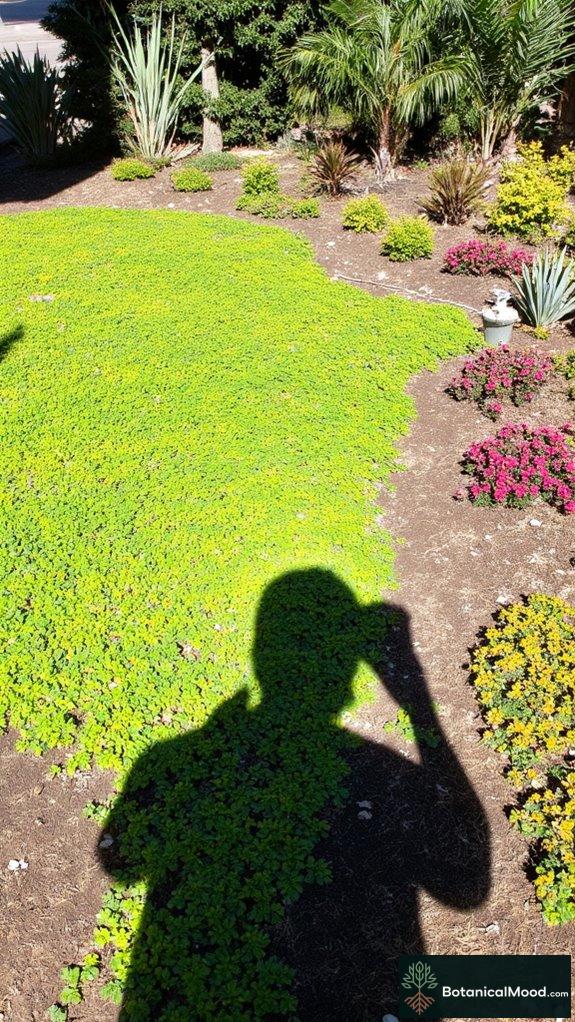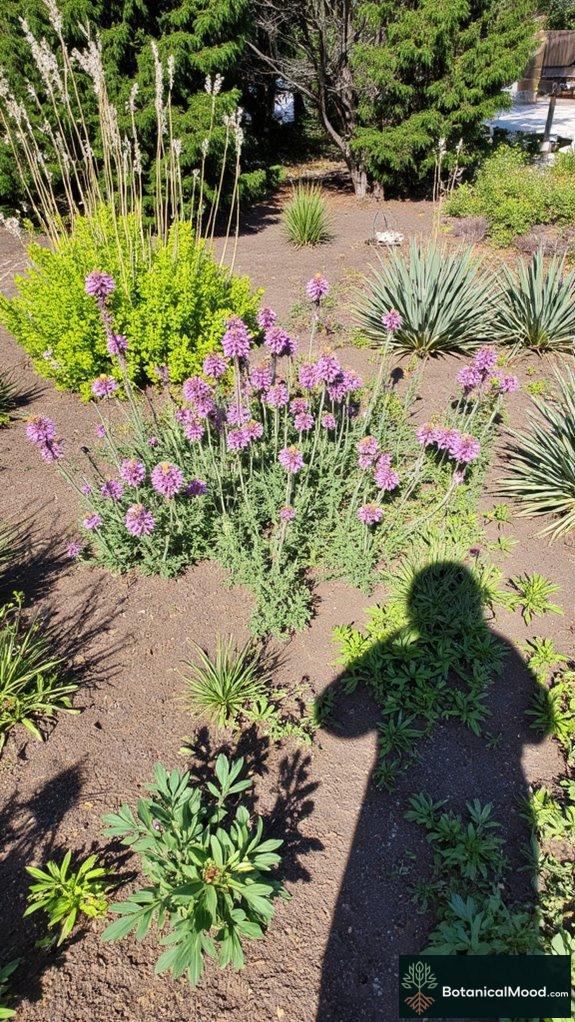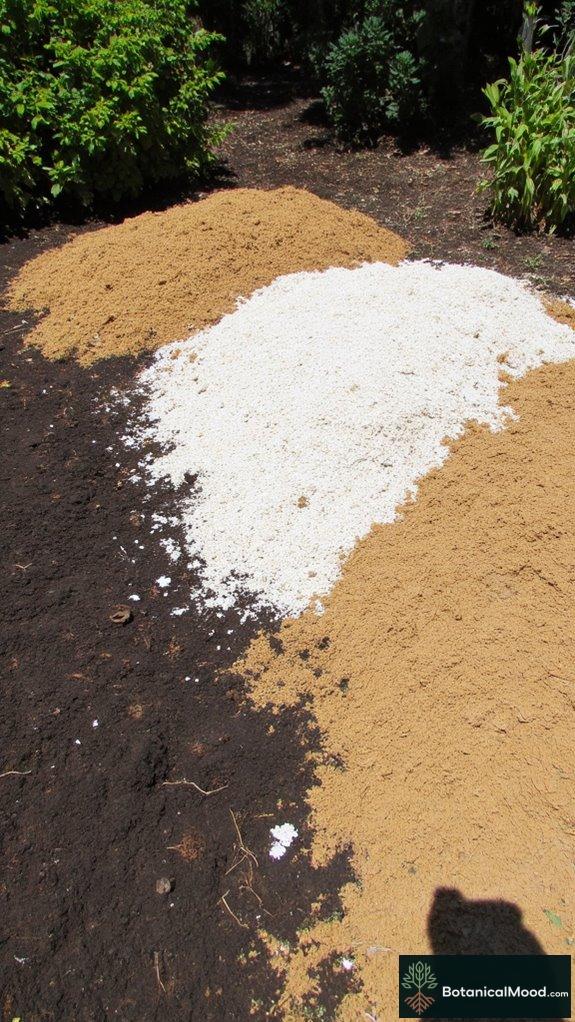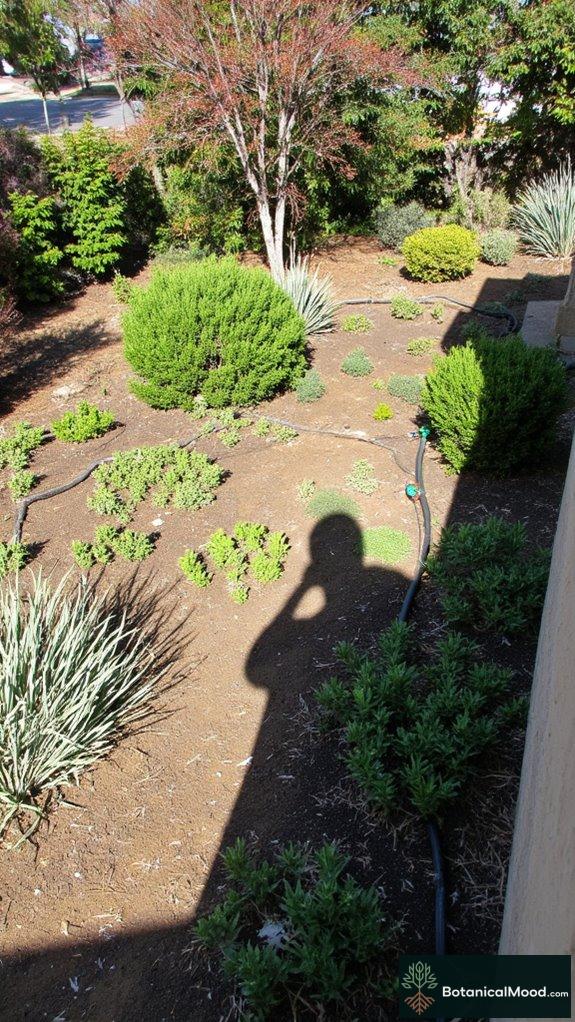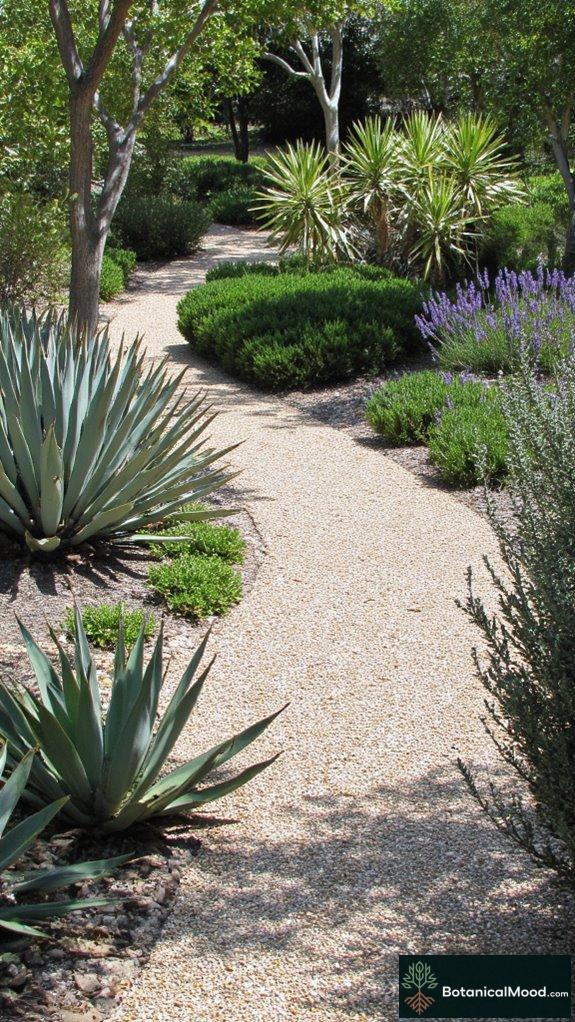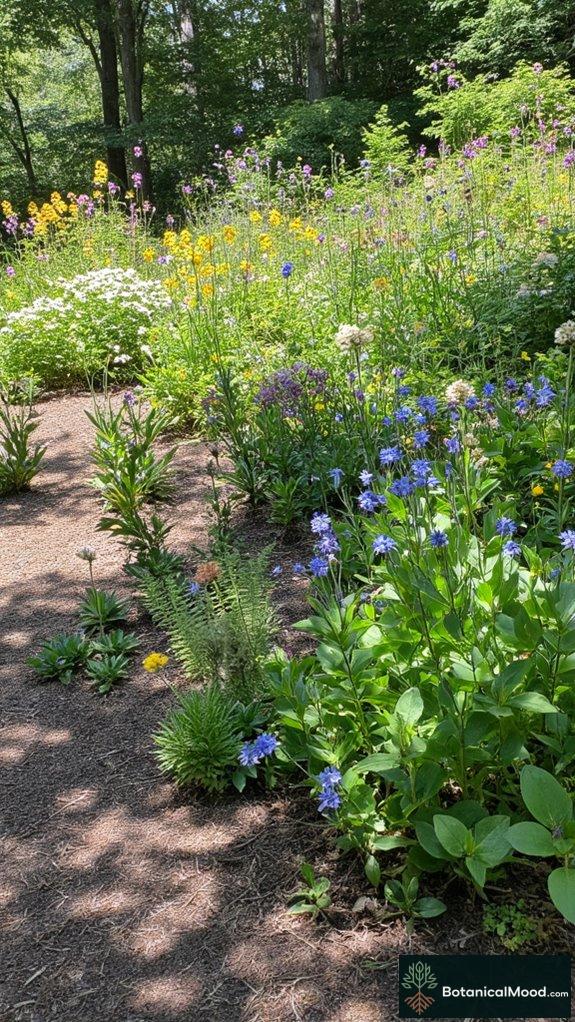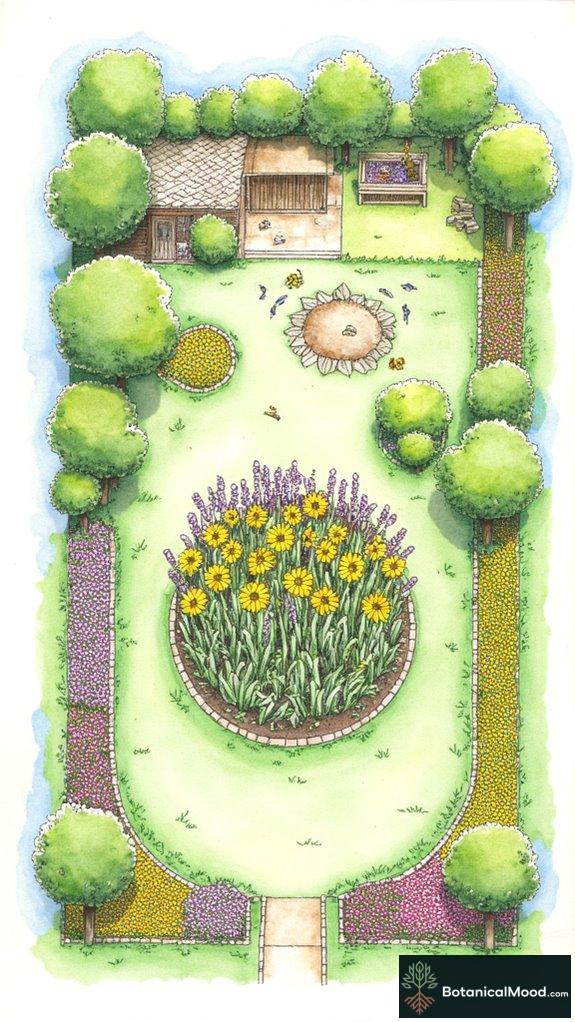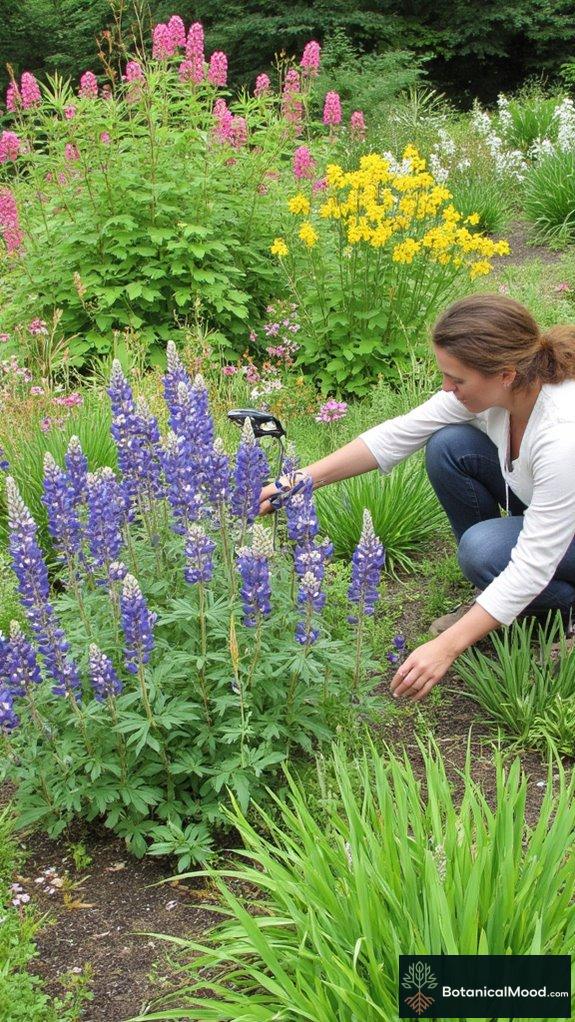Transforming my backyard into an eco-chic haven—who knew it could be this much fun?
Picture me battling the overgrown weeds, armed with Echinacea purpurea and Rudbeckia hirta. A native plant oasis was born, promising beauty with zero maintenance.
Then there’s the reclaimed wood I found—what a treasure! It totally elevates my hardscape, giving my space that edgy character while saving the planet.
Water-wise gardens with smart irrigation? Check. Edible crops like Chard? Double-check. I can’t wait for my friends to graze while lounging in my cozy outdoor area. Who knew eco-conscious could look this good?
—
Finding Zen in My Inconvenient Garden Oasis
I once thought designing a garden was about aesthetics. Boy, was I wrong! I learned cycling through my mother’s old backyard that sometimes you must let go of that vision of perfect symmetry.
One summer, I added an unexpected color palette with kaleidoscopic flowerbeds. My friends couldn’t help but notice how the native species attracted local bees. A mini-ecosystem right outside my door!
If I can weave nature’s chaos into delightful order, why can’t you? Let your imagination run wild with unique plants and sustainable practices, and trust me, the world will buzz with joy.
Quick Takeaways
- Create cozy outdoor living areas with weather-resistant furniture and eco-friendly fire pits for stylish gatherings and comfort.
- Design distinct zones for dining, social interaction, and activities to enhance functionality and flow in the backyard space.
- Implement sustainable hardscaping using reclaimed materials to add character while being environmentally responsible.
- Incorporate native plants in your landscaping to attract pollinators and promote ecological diversity, enhancing the garden’s aesthetic.
- Utilize ambient lighting options, such as solar-powered fixtures, to create a warm atmosphere for evening entertaining.
Native Plant Oasis for Low-Maintenance Beauty

Creating a native plant oasis not only enhances the aesthetic charm of your backyard, but it also fosters a sustainable environment.
Envision lush, vibrant vistas filled with native species like Echinacea purpurea and Rudbeckia hirta, attracting pollinators and providing habitats. These plants are tailor-made for your locale, thriving without excessive water or chemical fertilizers, eliminating the burden of high maintenance.
Picture vibrant landscapes filled with native blooms like Echinacea and Rudbeckia, thriving effortlessly while supporting pollinators and wildlife.
Embrace color variety with vibrant blooms that shift throughout the seasons, offering a constantly changing canvas. Additionally, incorporating native plant species can significantly bolster local biodiversity and contribute to a healthier ecosystem.
Plant strategically, layering heights to create depth: taller Baptisia australis in the back and low-growing groundcovers like Thymus serpyllum in the front.
As you cultivate this sanctuary, you’ll find not just beauty, but empowerment in nurturing your environment, a core value of my mission at Botanical Mood.
Sustainable Hardscape: The Charm of Reclaimed Materials

While many homeowners gravitate towards conventional materials for their outdoor spaces, turning to reclaimed resources can transform your hardscape into a unique and environmentally friendly feature.
Imagine paving your patio with salvaged bricks or creating a stunning path using repurposed stone. Not only do these materials boast distinctive textures, but they also tell a story, adding character to your design.
Incorporating reclaimed barn wood for benches or even fencing can infuse rustic charm alongside modern sustainability. Additionally, transforming reclaimed wood into decorative garden planters can provide both functionality and an artistic touch to your outdoor space.
Water-Wise Gardens: Incorporating Rain Gardens and Smart Irrigation

Water-wise gardens offer a beautiful and effective way to conserve resources while enhancing your surroundings. By incorporating elements like rain gardens—environments designed to manage stormwater runoff—and smart irrigation systems such as drip lines or weather-based controllers, I can optimize water use sustainably.
For example, using native plants like Rudbeckia hirta (black-eyed Susan) or Salvia nemorosa (wood sage) not only conserves precious water but also attracts pollinators and adds vibrant color.
I prefer brands like Rain Bird for irrigation, as they prioritize efficiency and reliability.
Through the strategic planting of these water-wise elements, I can create a striking environment that reflects both beauty and ecological responsibility. This is a demonstration of the kind of intelligently designed spaces I admire and aim to promote.
Edible Landscaping for a Functional Foodscape

Edible landscaping transforms ordinary spaces into productive foodscapes, enhancing both beauty and functionality.
I’ve discovered that integrating food-bearing plants not only appeals to the eye but also nourishes the soul.
Here are four powerful ways to create your own edible oasis:
- Herb Spirals: Incorporate fragrant herbs like Basil (Ocimum basilicum) and Thyme (Thymus vulgaris) in a vertical spiral design, optimizing space and sunlight.
- Fruit Trees: Select dwarf varieties like ‘Honeycrisp’ Apples (Malus domestica) to provide visual height and harvestable fruit.
- Vertical Gardens: Use trellises for Climbing Beans (Phaseolus vulgaris), adding green hues and maximizing small areas.
- Edible Borders: Create stunning edges with vibrant Chard (Beta vulgaris) and colorful Nasturtiums (Tropaeolum majus).
These choices reflect the ethos of Botanical Mood, where aesthetic beauty meets productivity.
Cozy Outdoor Living Rooms for Stylish Gatherings

Creating a cozy outdoor living room transforms your backyard into a stylish retreat, inviting friends and family to gather in comfort and style.
Envision sumptuous seating adorned with weather-resistant fabrics, like Sunbrella, paired with chic, sustainable coffee tables crafted from reclaimed wood.
I recommend adding a fire pit, perhaps a modern, eco-friendly model from Solo Stove, which creates a focal point for gatherings and extends the season for outdoor entertaining.
Surround the area with soft, ambient lighting—string lights or solar lanterns—to create an inviting atmosphere.
To enhance the experience, consider incorporating lush textiles—think textured throws or vibrant cushions—while selecting durable planters like those from Lechuza to showcase your favorite plants.
Embrace this beauty, and redefine chic outdoor living.
Vertical Gardens: Maximizing Space and Greenery

While many people may overlook vertical gardening as a clever solution for small spaces, I find it an inspiring way to maximize greenery and infuse life into any backyard.
Vertical gardening is a brilliant way to enhance small spaces and breathe life into your backyard.
This innovative design choice seamlessly integrates nature into your environment, making it an essential element for stylish entertaining.
Here are four powerful features of vertical gardens:
- Space Optimization: Transform unused walls into lush backdrops, utilizing every inch effectively.
- Air Quality Enhancement: Plants like *Spathiphyllum* (Peace Lily) purify the air, creating a healthier atmosphere.
- Aesthetic Appeal: Varied textures and colors—think *Hedera helix* (Ivy) combined with *Stachys byzantina* (Lamb’s Ear)—add depth and intrigue.
- Easy Maintenance: Many modern systems, like living wall panels, simplify care and irrigation.
Plant one, and watch your backyard flourish!
Pollinator-Friendly Spaces: Enhancing Biodiversity and Beauty

Designing such spaces requires an understanding of both aesthetics and ecology, where choosing the right plants, in harmony with their surroundings, is key. By selecting native flowers that bloom at various times, we can provide year-round nourishment for essential pollinators. Envision a space filled with colorful blooms, like Echinacea purpurea and Monarda didyma, drawing in butterflies and bees while enhancing our outdoor experience.
Here’s a curated selection of plants that excel in boosting biodiversity and visual appeal:
| Plant Name | Attracts |
|---|---|
| Echinacea purpurea | Bees, Butterflies |
| Monarda didyma | Hummingbirds |
| Asclepias tuberosa | Monarch Butterflies |
| Salvia nemorosa | Bees |
Creating a pollinator-friendly oasis serves dual purposes, blending beauty with ecological necessity.
Embracing Native Plants for Biodiversity

When you choose to incorporate native plants into your garden, not only do you enhance your scenery’s beauty, but you also contribute to local biodiversity in a meaningful way.
By selecting native species, such as Echinacea purpurea or Monarda didyma, you create natural pollinator habitats that are essential for butterflies and bees.
Choosing native plants like Echinacea purpurea and Monarda didyma fosters essential habitats for butterflies and bees.
These plants thrive in your local environment, requiring less maintenance and fewer resources than exotic varieties. Additionally, incorporating bee-friendly flora attracts a variety of pollinators, bolstering the overall health of your garden ecosystem.
I’ve witnessed how incorporating such flora transforms my space, attracting vibrant wildlife while offering aesthetic appeal.
Each bloom not only enriches the garden but also supports the ecosystem, embodying the essence of a truly sustainable design.
Multi-Functional Outdoor Living Rooms

As I explore the world of outdoor living design, it becomes increasingly clear that transforming a simple backyard into a multi-functional outdoor living room can greatly enhance both its aesthetic appeal and usability.
By incorporating stylish outdoor furniture, such as modular seating and a dining area, we create spaces for relaxation and entertaining.
Complementing these elements, ambient lighting—like string lights or lanterns—invites warmth and coziness during evening gatherings. Incorporating creative low voltage lighting not only highlights architectural features but also enhances the overall atmosphere of the outdoor space.
With thoughtful planning, I believe we can design a sanctuary that harmonizes with nature and serves multiple purposes, perfect for both intimate family gatherings and lively soirées, all while embracing eco-chic elegance.
Smart Technology for Sustainable Convenience

Integrating smart technology into backyard designs is an innovative approach that enhances both sustainability and convenience, allowing us to enjoy our outdoor spaces with even greater ease.
Smart irrigation systems, for example, optimize water usage by adjusting based on weather conditions, ensuring our plants thrive without wasting resources.
Meanwhile, energy-efficient lighting not only sets the mood for evening gatherings but also reduces electricity consumption, highlighting our commitment to eco-friendliness.
By controlling these elements via a smartphone app, we gain the ability to manage our gardens proactively and with precision.
Such technologies truly elevate our eco-chic outdoor living experience.
Creative Vertical Gardens and Green Walls

There’s something uniquely appealing about vertical gardens and green walls that can transform any backyard into an urban oasis bursting with life.
With vertical gardening techniques, you can maximize space while adding visual interest. Wall mounted planters, like those from Green Wall or Vertical Garden Systems, allow you to experiment with colors and textures.
Consider using cascading plants like Bacopa (Sutera cordata) paired with trailing vines, which creates striking layers.
These designs enable effective water management and support biodiversity, enhancing your garden’s aesthetic.
As I explore these eco-chic concepts, I’m inspired to create a beautiful environment that reflects my passion for nature.
Foodscaping: Blending Beauty With Edibles

While the allure of a thriving garden often stems from stunning floral displays and lush greenery, foodscaping seamlessly merges aesthetics with functionality, inviting us to cultivate beauty alongside edibles.
Imagine curating herb gardens, like fragrant basil (Ocimum basilicum) and vibrant rosemary (Salvia rosmarinus), interspersed with edible flowers such as pansies (Viola tricolor) and nasturtiums (Tropaeolum majus).
These choices not only enhance your outdoor décor but also offer culinary delights.
Eco-Friendly Hardscaping Solutions

As I explore the world of eco-friendly hardscaping solutions, I find that selecting the right materials can greatly elevate a garden’s aesthetic while promoting sustainability.
Here are four effective choices to contemplate:
- Permeable pavements: These allow rainwater to filter through, minimizing runoff and promoting groundwater recharge.
- Recycled materials: Utilizing reclaimed wood or bricks adds unique character while reducing waste.
- Natural stone: A durable option that blends beautifully with surroundings.
- Cement alternatives: Contemplate options like fly ash or hempcrete for eco-efficient structures.
Year-Round Use Spaces for Relaxation and Socializing

Creating inviting year-round use spaces for relaxation and socializing can transform an ordinary backyard into a vibrant retreat, seamlessly blending the indoors with nature’s beauty.
| Feature | Details |
|---|---|
| Cozy Firepits | Ideal for chilly evenings |
| Outdoor Kitchens | Perfect for culinary delights |
| Covered Gazebos | Shelter from rain or sun |
| Ambient Lighting | Enhances evening enjoyment |
Sustainable Garden Planning

Sustainable garden planning serves as the foundation for creating resilient ecosystems that flourish in harmony with our environment.
By employing eco-friendly practices, you can greatly enhance your outdoor space while ensuring it thrives. Here’s how to get started:
Employing eco-friendly practices enriches your outdoor space and fosters a thriving, sustainable environment.
- Use native plants: Incorporating local flora like Echinacea purpurea not only supports local wildlife but also requires less maintenance.
- Implement rain gardens: Design areas that capture stormwater, utilizing it to nourish plants like Iris versicolor while reducing erosion.
- Embrace biodiversity: Create a mosaic of habitats, encouraging various species, from pollinators to birds, to visit your garden.
- Opt for organic solutions: Choose eco-friendly fertilizers and pest control, protecting the environment from harmful chemicals.
With these principles, every garden can become a powerful statement of ecological stewardship.
Eco-Friendly Outdoor Gathering Areas

Creating inviting outdoor gathering areas transforms backyards into vibrant spaces for connection and enjoyment. By choosing eco-friendly materials and furniture, I guarantee my space not only amazes aesthetically but also respects the planet.
| Material | Benefits | Examples |
|---|---|---|
| FSC-Certified Wood | Sustainable sourcing | Tables and benches |
| Recycled Plastic Composites | Low maintenance and durable | Patio furniture |
| Organic Cotton | Reduced chemical exposure | Cushions and upholstery |
| Solar-Powered Lighting | Energy-efficient and durable | Pathway lights and accent features |
With thoughtful selections such as bamboo utensils and rainwater harvesting systems, I cultivate serenity while minimizing waste, embodying a lifestyle that champions sustainability. This dedication commands more profound gatherings with nature’s bounty in mind.
Zoning for Social Interaction

Understanding how to effectively zone your backyard can elevate social interactions and create meaningful spaces conducive to connection.
Here’s how to achieve ideal zoning:
- Define Zones: Create distinct seating, dining, and activity areas to encourage varied engagement.
- Enhance Sight Lines: Maintain open sight lines between zones, allowing communication while preserving the spatial variety.
- Utilize Buffer Zones: Integrate planting beds (e.g., Lavandula angustifolia) or low fences to balance openness and privacy, catering to both intimate chats and group gatherings.
- Allow Multiple Entry Points: Design pathways that promote flow, facilitating effortless movement and spontaneous congregation spots.
Meet the Creative Visionary

Sarah Thompson, a passionate environmentalist from Portland, Oregon, sought to create an eco-chic backyard after witnessing the impact of urban development on local ecosystems. This experience inspired her commitment to sustainability in design.
To realize her vision, Thompson collaborated with local green space architects and horticulturists. She attended workshops on sustainable gardening and explored innovative design concepts. This thorough process included analyzing the yard’s layout, selecting native plants, and integrating eco-friendly practices to cultivate a beautiful and functional space.
Using tools like a precision soil tester and garden design software, Thompson incorporated essentials from brands like EcoFlow for smart irrigation systems and sturdy BioLiving raised beds.
Collaborating with eco-conscious horticulturists guaranteed a rich selection of drought-resistant plants and pollinator-friendly species, fostering a vibrant natural habitat.
Botanical Gardens Across America
Botanical gardens across America serve as vibrant sanctuaries for plant diversity, showcasing the beauty of flora while playing a vital part in conservation and education.
With approximately 600,000 living plant accessions representing about 40,000 species, these gardens—spanning gorgeous spaces like Longwood Gardens (Pennsylvania) and the Fairchild Tropical Botanical Garden (Florida)—embody grandeur and ecological balance.
Visiting engaging sites like the New York Botanical Garden (Bronx) offers immersive experiences, while Tucson Botanical Gardens (Arizona) delights with themed urban collections reflective of the Sonoran Desert’s charm.
With over 300 million annual visitors, these botanical havens not only nurture plant conservation but also inspire audiences, revealing the true power of nature while contributing profoundly to environmental awareness and community engagement.
Historic Royal Gardens in France
The grandeur of historic royal gardens in France reflects an era of opulence and artistic expression, where nature was meticulously orchestrated to symbolize power and elegance.
| Garden Style | Key Features | Historical Significance |
|---|---|---|
| French Garden | Geometric symmetry | Royal power and order |
| Gardens of Versailles | Fountains, grand vistas | Louis XIV’s ambition |
| Petit Trianon | Exotic plants, intimate spaces | Shift to personal taste |
Exploring these gardens reveals the sophisticated design and elegant detail of each French garden, creating an enhanced appreciation for royal symbolism. It’s fascinating how these spaces invite you to exercise control over nature itself.
Garden Design FAQ
How Can I Choose the Right Native Plants for My Region?
Choosing the right native plants for your region is essential for creating an eco-friendly garden.
I always start by researching local flora, like Echinacea purpurea (Purple Coneflower) or Rubus idaeus (Red Raspberry), which thrive in my climate. Visiting nurseries specializing in native species, like the Native Plant Society, has educated me on plant compatibility.
I evaluate sunlight, soil conditions, and aesthetic preferences. This balance cultivates a thriving space that’s alive with biodiversity and beauty.
What Are the Benefits of Using Permeable Pavers in Landscaping?
Using permeable pavers in landscaping brings numerous benefits. They allow water to infiltrate, reducing runoff and minimizing erosion, which I’m all for.
They also promote healthier soil and plant growth by replenishing groundwater. Brands like Belgard or Techo-Bloc offer stylish options that align with eco-friendly aesthetics.
Plus, these pavers create a visually appealing surface while maintaining functionality, making them perfect for my garden designs. Their environmental advantages truly embody the ethos of Botanical Mood.
How Often Should I Water My Rain Garden?
I typically water my rain garden (e.g., rain garden plants like Iris versicolor) every one to two weeks, but I always assess the moisture level first.
During dry spells, I increase the frequency, as even resilient plants need consistent hydration.
Mulching helps retain moisture, so I often use organic options, like shredded leaves, to enhance both aesthetics and health.
Keep in mind, a well-tended rain garden not only conserves water but celebrates nature’s beauty.
Can I Mix Ornamental and Edible Plants in the Same Garden?
Absolutely, I can mix ornamental and edible plants in the same garden.
In fact, combining vibrant flowers like Echinacea (coneflower) with herbs such as basil (Ocimum basilicum) creates a stunning visual while providing fresh flavors for my dishes.
I’ve found that arranging taller ornamental grasses like Miscanthus sinensis behind low-growing veggies like strawberries (Fragaria × ananassa) enhances both beauty and yields.
This synergy not only enriches my space but also invites beneficial pollinators to thrive.
What Furniture Materials Are Best for Eco-Friendly Outdoor Living Spaces?
For eco-friendly outdoor living spaces, I favor sustainably sourced materials like reclaimed wood, bamboo (Bambusoideae), and recycled aluminum.
These options not only reduce carbon footprints but also add aesthetic warmth and modern appeal. Stylish natural textiles, such as organic cotton and hemp, complement such designs beautifully.
Brands like Fermob and Loll Designs offer chic selections that combine durability with environmental consciousness.
Investing in these materials, I’m creating a stylish space that respects nature’s beauty.
References
- https://serenewatergardens.com/top-5-backyard-trends-for-2025-transform-your-outdoor-living-space/
- https://www.youtube.com/watch?v=mdkwleh3vLY
- https://barefootgardendesign.com/eco-friendly-landscape-designs-2025/
- https://morellandscaping.com/2025/04/15/top-2025-landscaping-trends-eco-friendly-low-maintenance-and-beautiful-outdoor-ideas/
- https://blog.techo-bloc.com/12-backyard-trends-2025-top-landscape-outdoor-design
- https://www.drabtofab.com/landscape-design-san-diego-sustainable-solutions-for-modern-outdoor-living-in-2025
- https://www.obrienlandscape.com/blog/5-landscape-design-trends-for-2025
- https://www.thisoldhouse.com/home-finances/outdoor-living-trends
- https://www.masterspas.com/blog/backyard-design-trends-for-2023/
- https://crrhospitality.com/blog/creating-inviting-green-spaces-in-outdoor-hospitality-venues/
- https://bullmountainlivingllc.com/sustainable-outdoor-design-eco-friendly-practices-for-responsible-outdoor-living/
- https://s3da-design.com/designing-sustainable-outdoor-spaces-a-guide-to-eco-friendly-landscaping/
- https://www.truegridpaver.com/eco-park-design-ideas/
- https://www.grasshoppergardens.com/resources/blog/creating-sustainable-and-attractive-outdoor-spaces/
- https://wllw.eco/blogs/journal/healthy-outdoor-design-ideas
- https://www.extraspace.com/blog/home-organization/eco-friendly-backyard-ideas/
- https://sperbercompanies.com/sustainable-landscape-design-that-make-outdoor-spaces-great/
- https://depts.washington.edu/hhwb/Thm_Community.html
- https://pmc.ncbi.nlm.nih.gov/articles/PMC9763895/
- https://toprailfences.com/blog/insights/people-hiding-from-neigbors/
- https://pmc.ncbi.nlm.nih.gov/articles/PMC3134498/
- https://www.avlv.com/how-design-architecture-influence-social-interaction-at-home/
- https://bobbykdesigns.com/top-10-landscape-design-trends-for-2025/
- https://en.wikipedia.org/wiki/List_of_botanical_gardens_and_arboretums_in_the_United_States
- https://www.pacaso.com/blog/top-10-botanical-gardens-in-the-u-s
- https://www.publicgardens.org/20-most-popular-us-botanical-gardens/
- https://www.usbg.gov
- https://www.nybg.org
- https://longwoodgardens.org
- https://btarboretum.org


























































